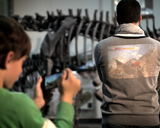Pocket-Sized Laser Projection

For years, Fraunhofer IPMS has been working on scanning mirrors for light deflection in one and two dimensions. Alongside resonant scanners with constant sinusoidal movement, a quasi-static variation has also been available for a while, which serves to make linear movement or static orientation in a specified position possible. Both types make compact laser projection systems possible in practice. At the SID DisplayWeek from May 23 – 25 in Vancouver, Canada, visitors will have the opportunity to become acquainted with the technology.
For a few years they have already been regarded as the ultimate component feature of future mobile devices: Projectors so small that they can be integrated into the devices themselves ("pico-projectors"). Whether it‘s the holiday pictures that were taken with the device or videos downloaded from YouTube to be shown privately, or even presentations made to small groups in a business setting; the integrated projectors are certain to open up additional advantages and innovative applications for smart phones or tablets. Projections in the size of a TV screen, even at a short projection distance, appear possible even today, and HD resolution is also in demand.
Fraunhofer IPMS is one of the few pioneers to offer solutions for pico-projectors. The Institute concentrates on the "laser beam steering" principle for image generation. Here, a brightness controlled laser beam (e.g. three, in red, green and blue, for full color display) is directed by a single miniaturized scanning mirror over the projection surface fast enough to generate an image which appears cohesive to the human eye. The scanning mirrors typically have a diameter of about one millimeter and are manufactured from mono-crystalline silicon wafers using established processes in cost-effective, large batches in the MEMS clean room at Fraunhofer IPMS. Fraunhofer IPMS utilizes an electrostatic actuator with comb shaped electrodes for the necessary movement of the scanning mirrors. It was easy to make one and two dimensional scanners with conventional planar structures (i.e. mirror, outer frame and actuator combs lay on one plane). However, in this case, the resonating frequency is set, and changing the horizontal frequency, for example, is hardly possible. For another thing, the high scan frequencies bound to the double resonant principle are contrary to the trend toward increasing pixel counts in the projected image – right up to full HD.
These disadvantages are overcome with the new quasi-static scanner concept from Fraunhofer IPMS, called LinScan,. This was accomplished without having to change the basic technology so that our customers continue to profit from a mature manufacturing process. One subsequent micro-assembly step, along with a small modification to the mechanical design is sufficient to permanently tilt the actuator combs toward each other. The Institute was able to show that the combination of a resonant actuator on the quick horizontal axis and LinScan on the slower vertical axis is possible for a two-dimensional scanner like those necessary for pico-projectors. The laser beam can now make targeted jumps from line to line according to an externally configured frequency. Pico-projectors with a SVGA resolution (800 × 600) and higher will be accomplished with no difficulty. As no projection optics are necessary, the result is always a sharp image, regardless of the distance between the projector and the screen. Additionally, curved projection surfaces, such as those found in cars with head-up displays, no longer pose a problem. LinScan is naturally suited to all applications that demand the static alignment of a laser beam or scanning with variable frequencies.
At the SID DisplayWeek 2013, the leading trade show for display technology, Fraunhofer IPMS will be presenting a demonstrator that unites both variations of the scanner technologies available at the Institute. Both the compactness of the projection modules that are based upon the resonant scanners as well as the additional possibilities of the LinScan technology with the same component size will be clearly demonstrated. Visitors are warmly invited to exchange information at booth number 1209 (part of the German Pavilion).
About Fraunhofer IPMS
The Fraunhofer Institute for Photonic Microsystems IPMS and its 200 employees turn over an annual research volume of 20 million euros. Fraunhofer IPMS generates more than two thirds of this production capacity out of commissions from industry and publicly financed projects in applied research. The focus of our development and production services lies in the practical industrial application of unique technological know-how in the fields of (optical) micro-electromechanical systems [MEMS, MOEMS]. Fraunhofer IMPS uses scientific know-how, application experience and customer contacts as well as modern equipment and clean room infrastructure. Fraunhofer IPMS covers a broad spectrum of industrial applications. Our services range from initial conception to product development, right down to serial pilot production – from a single component to a complete system solution.
 Fraunhofer Institute for Photonic Microsystems
Fraunhofer Institute for Photonic Microsystems